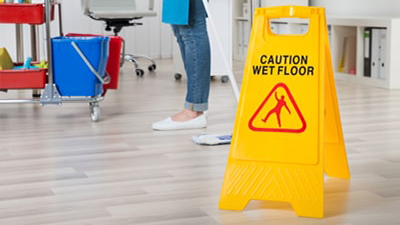Health & Safety in schools and academies

Health & Safety risk assessments are a statutory requirement under the Health & Safety at Work Regulations 1999, so it is essential that schools engage in this practice to remain compliant and ensure the safety of their pupils and employees. In this article, Sara Rawnsley explores the statutory duties and responsibilities for educational settings.
It is a requirement of the Management of Health & Safety at Work Regulations 1999 that, as an employer, you have access to one or more Competent Persons for advising and assisting you with your health and safety responsibilities.
So, what is a Competent Person?
According to DfE Health and Safety: Responsibilities and duties for schools, schools must appoint a competent person to ensure they meet their health and safety duties. A competent person is someone with the necessary skills, knowledge and experience to give sensible guidance about managing the health and safety risks at the school. This can be someone appointed directly by the school, one or more of its staff, or the employer can arrange support from outside the school. In most schools, the senior leadership team can manage risks.
Health & Safety Policy
Schools must have a health and safety policy in place. This should be an integral part of the school’s culture, values and performance standards. The key elements of the policy should:
- set out the roles and responsibilities within risk management processes;
- set out the mechanisms to control risk;
- set out specific control measures that need to be implemented.
Every health and safety policy is separated into 4 elements:
- Plan
- this is where leaders should set the direction for effective health and safety management;
- Do
- this is to introduce the management systems and practices that ensure risks are dealt with sensibly, responsibly and proportionately;
- Check
- the processes in place for monitoring and reporting;
- Act
- what and how a formal management review of health and safety performance can be carried out.
The Health and Safety Executive (HSE) set out in their guidance, Leading health and safety at work that a school's Health & Safety policy should include:
- a general statement of the policy;
- who is responsible for what (delegation of tasks);
- arrangements for risk assessments and the practical control measures to reduce risk;
- how the school will establish, monitor and review its measures to meet satisfactory health and safety standards.
So, what is a risk assessment?
A risk assessment is a process of identifying hazards, evaluating risks and controlling or eliminating those hazards during daily tasks and activities. The next part of this process involves applying control measures to make sure staff and pupils, as well as any visitors or contractors to your site, are safe. Ultimately, reasonable steps must be taken to prevent potential harm that has been identified during the assessments. There is also a requirement to keep written records of all risk assessments.
How often should a risk assessment be carried out?
There are a few factors that determine how often an assessment should be conducted. These include:
- Internal incidents
- If there's an incident in your School, your competent person should look at how it happened and see if there are any gaps that need filling in your risk management programme;
- External incidents
- If an incident happens outside of your School, you can use that as an opportunity to audit your current processes;
- Process change
- If you've evaluated your processes and decided something needs to change, it is important to risk assess any new processes you put in their place;
- New equipment
- When you have new equipment, make sure you understand the potential hazards and risks of using it;
- New employees
- If you've got a new employee taking over a process or activity, it is best practice to perform hazard identification before they begin;
- New environment
- Such as an office move. Is an employee working from height? If the environment of an activity changes, carry out a new risk assessment.
It is also crucial to note that the effectiveness of risk assessment compliance depends on how well it is communicated to employees. Therefore, Schools must regularly review and update their risk assessments, treating them as 'living documents', as the circumstances in your school and the public health advice changes. This includes having active arrangements in place to monitor whether the controls are effective and working as planned. This was very much the case during the recent pandemic.
What approach can we take to risk estimation and management of public health incidents?
Some types of control are more effective at reducing infection risks than others. Risk reduction measures should be assessed in order of priority. These are the steps to be worked through to address risks, considering for each risk whether there are measures in each step that can be adopted before moving onto the next step.
- Elimination: stop an activity that is not considered essential if there are risks attached;
- Substitution: replace the activity with another that reduces the risk. However, care is required to avoid introducing new hazards due to the substitution.;
- Engineering controls: design measures that help control or mitigate risk;
- Administrative controls: identify and implement the procedures to improve safety (for example, markings on the floor, signage).
Having gone through this process, personal protective equipment (PPE) should be used in line with UK Health Security Agency guidance.
Schools must therefore make sure that a risk assessment has been undertaken to identify the measures needed to reduce the risks from public health incidents so far as is reasonably practicable. General information on how to make a workplace secure is provided by the Health and Safety Executive’s (HSE) guidance on Health and Safety at Work.
School security and emergency preparation
All schools should have plans in place to enable them to manage and respond to incidents related to school security. Schools should also have procedures for controlling access and barring individuals from premises. They can decide whether to include this within their school security plan or deal with the issue when it arises in another plan or procedure. The DfE recommends guidance on helping schools with accessing and barring of individuals from premises. For Health and safety emergency procedures schools should consider include:
- serious injury to a pupil or member of staff (for example, transport accident);
- significant damage to school property (for example, fire);
- criminal activity (for example, bomb threat);
- severe weather (for example, flooding);
- public health incidents (for example, flu pandemic);
- the effects of a disaster in the local community.
The DfE provides information and guidance in their document- Emergency planning and response for education, childcare, and children's social care settings.
Staff Training
Schools must ensure that staff receive information and training about health and safety. This includes:
- how to assess risks specific for their job;
- how to meet their roles and responsibilities identified within the health and safety policy.
They can do this in different ways depending on individual or specific need. For example, providing staff with written guidance may be appropriate in some cases, while attending a training course may be more appropriate for others.
For staff whose work involves a greater element of risk, such as site staff, they will need extra or specific training. The HSE risk management guidance provides information about when staff require specific training in, for example:
- using industrial machinery;
- managing asbestos;
- having responsibility for the storage and accountability for potentially hazardous materials in their buildings.
The DfE also provide information about the safe storage and disposal of hazardous materials in their guidance Storing and disposing of hazardous chemicals in schools- Practical advice for teachers, technicians and other staff who buy, store or dispose of hazardous chemicals.
Duties on Employees
The law requires employees to:
- take reasonable care of their own health and safety and that of others who may be affected by what they do at work;
- co-operate with their employers on health and safety matters;
- do their work in accordance with training and instructions;
- inform the employer of any work situation representing a serious and immediate danger, so that remedial action can be taken;
- Employees should follow health and safety procedures put in place by their employer;
- Teachers and other staff in schools have a common law duty when in charge of pupils to take the same care of them as they would as a parent.
Recording and reporting injuries and accidents
Certain work-related injuries to a member of staff or a child must, by law, be recorded and reported. The employer or proprietor is responsible for this, but staff may be asked to prepare the report. HSE explain, how, where and when to report incidents in their education information sheet Incident reporting in schools (accidents, diseases and dangerous occurrences): Guidance for employers.
Reviewing and evaluating
Schools must regularly review and update their risk assessments (at least annually), treating them as 'living documents', as the circumstances in your school and the public health advice changes. This includes having active arrangements in place to monitor whether the controls are effective and working as planned. This was very much the case during the recent pandemic. So, as part of this monitoring, schools should investigate incidents to ensure that:
- they are taking appropriate corrective action;
- they are sharing learning;
- necessary improvements are put in place.
Where there is a health and safety incident at the school, the competent person and others with health and safety responsibilities, should assess the effectiveness of the school's procedures and its response. They should make necessary changes to policies and procedures.
Finally - The Law
- The The Health and Safety at Work etc. Act 1974 determines British health and safety law. The Health and Safety Executive (HSE), with local authorities, enforce this Act;
- The Management of Health & Safety at Work Regulations 1999 supports the Act.
All educational settings should make sure they are familiar with both of these documents.
Click the following links for more information on our Health & Safety and Risk Assessment training.
Sara Spinks
SSS Author & Former Headteacher











